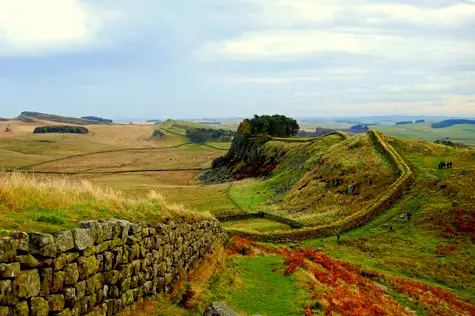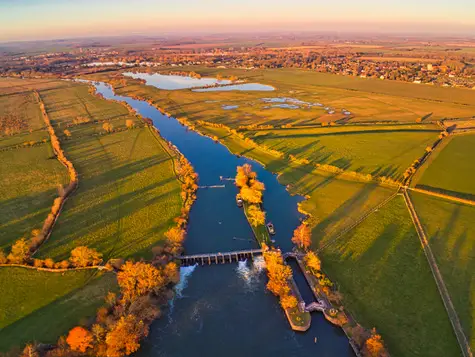7 of the Greatest Hiking Trails in Great Britain
British hiking trails often get overlooked due to tourists focusing their attention on Britain’s other more iconic attractions like Stonehenge, Buckingham Palace, and the Tower of London. However, there’s more to the U.K. than just its crowded tourist sites and the real kings and queens are the mystical lochs, white seaside cliffs, and towering peaks like Ben Nevis.
From day hikes to long-distance treks that take weeks to complete, Europe’s largest island is home to some truly awe-inspiring walks that will have you getting up close and personal with Great Britain’s wild side. There’s never been a better time to check out Great Britain’s greatest hiking trails, being that many attractions are closed or have restrictions in place and social distancing has become the aim.


Things to Know Before Hiking in Great Britain
Thanks to the Countryside and Rights of Way Act of 2000, public access to the English and Welsh countryside and common land was made a lot easier. A similar land reform act was enacted by Scotland, allowing people of all three countries to walk freely over mapped mountain, moor, heath, and downland across Great Britain.
While Britain’s hiking trails may look beautiful, they can be rugged and treacherous at times so a bit of planning is vital to ensure your health and safety. One of the first things to think about is having appropriate footwear since your feet will be taking the brunt of the abuse during your hikes. The best hiking boots for navigating Great Britain’s rugged terrain should offer a few key elements.
You want hiking boots that are snug but still allow a bit of room for swelling since it is common for your feet to swell in heat and during rigorous activity. A more seamless hiking boot will hold up to the elements better and prevents water from seeping in. Materials like full grain leather will provide further water resistance along with providing much needed durability. It’s all about getting that right balance of durability, breathability, and comfort. You want a hiking boot that provides traction but also allows you to still feel the ground underfoot so you can easily navigate uneven terrain. And always remember to break-in new hiking boots with short hikes before heading out on a long trek in order to avoid suffering from blisters and sore feet.
When choosing what to wear hiking is recommended you dress using the 3-layer system consisting of a base layer made of merino wool or synthetic material that will wick moisture away from your skin, a mid-layer for insulation, and a waterproof outer or shell layer. Cotton clothing is very slow to dry and can make you very uncomfortable should it get wet, possibly even leading to hypothermia depending on the season and temperatures.
Your hiking pack should include a small first-aid kit to attend to potential minor injuries, hat and sunscreen to protect you from the sun, a torch in case you are forced to hike in the dark, maps and a compass in case your GPS or smartphone navigation app fails, a British trail guide, and a water purification device or purifying tablets if you won’t be able to carry enough bottled water and will be acquiring water from natural sources.
Always inform someone where you are hiking and when you expect to return. You should always hike with someone whenever possible or possibly book a guided walk if you are not familiar with what to expect with British hiking. If you do go ahead with a self-guided hike, always check the weather forecast and understand that conditions in Great Britain can change dramatically very quickly. A quick change in weather can lead to dangerous temperatures, make the ground slippery, and possibly result in flooded rivers making them impassable.
The ideal hiking season in Great Britain is May to October, but many of the region’s trails can be walked year round. Now that we’ve covered some of the important safety information, here are our favourite hikes around Great Britain that will introduce you to some incredible landscapes, interesting history, and hopefully a bit of wildlife.


Lizard Coastal Walk
The Lizard Coastal Trail is a looping 11-kilomtre track that takes in the southernmost point in mainland Britain. Situated in Cornwall, the walk takes in the rugged shoreline as well as green fields covered by seasonal wildflowers. The walk will take you around four hours to complete, during which time you might spot basking sharks feeding on plankton at sea as well as rare birds along the sea cliffs and further inland.
The walk takes in the beautiful beach at Kynance Cove, one of England’s best beaches which has been a favourite since the Victorian era. Take in Lizard Point, the southernmost tip of Great Britain, as well as the lighthouse. There are also a number of significant historic sites to experience along the way.
Hadrian’s Wall Walk
Walk along Britain’s largest Roman archaeological structure by hiking along the Hadrian’s Wall. This wall runs from coast to coast nearly acting as a boundary between Scotland and England, although technically the wall is entirely within England’s borders. The wall dates back to the 2nd century when its construction was ordered by the Roman emperor Hadrian. Now listed as a UNESCO World Heritage Site, visitors can walk the roughly 140-kilomtre wall path to take in its forts and watch towers.
It is said well over 10,000 people walk Hadrian’s Wall annually, most choosing to walk the path from east to west as they begin in Wallsend and end in Bowness-on-Solway. The wall was constructed over seven years and as much as 15,000 labourers were needed. Interestingly, only about 10% off the current wall you see is original, as repairs have been made over the centuries due to stone being destroyed, buried, or removed. One of the walls most fascinating sections is a roughly 30-kilomtre stretch between Chollerford and Birdoswald Fort, as this section offers the highest portions of the wall and provides views of the Lake District and Pennine Hills.

Coast to Coast Walk
Double the length of Hadrian’s Wall Walk is the 300-kilometre Coast to Coast walk that passes through three of Great Britain’s most notable national parks including Yorkshire Dales National Park, Lake District National Park, and North York Moors National Park.
The walk was the idea of British fellwalker Alfred Wainwright and considered to be one of the world’s top walking trails. Located in Northern England, the trail allows you to step foot in both the North Sea and Irish Sea if you walk its length. Most hikers take about two-weeks to complete the trek, each day-long section ending in locations that offer accommodation for the night. If you wish to break a record, you can try to run the path in under 40 hours which incredibly has been done before.
This unsignposted long-distance footpath requires the use of maps and careful navigation. It will take you through mountains and forests, along lakes, and introduces you to some truly historic places. The seaside village of St Bees makes for a great starting point.


Cuthbert’s Way
This 100-kilomtre trail crosses the border between Scotland and England, heading from the inland hills to the coast. St. Cuthbert’s Way begins from the small Scottish Borders town of Melrose and tracks all the way to England’s Holy Island of Lindisfarne off the northeast coast.
Many sites along the trail are associated with St. Cuthbert, the 7th century Anglo-Saxon saint of the Northumbrian church from which the trail takes its name. You’ll have a chance to walk in the great saint’s footsteps and witness St. Cuthbert’s Cave which was a temporary burial site for the saint.
The walk offers a wealth of historical and cultural interest, passing historic abbeys and castles along the way. You are rewarded at the end of journey with one last leg across a tidal causeway of which you will need to wait for a low tide. This leads to Holy Island which is home to a 16th century castle known as Lindisfarne Castle. Battles between the Scots, the English, and even Vikings took place in the region due to its strategic position. The island was an important centre of Celtic Christianity under several saints including Aidan of Lindisfarne and Cuthbert.
Thames Path National Trail
There’s no better way to experience England’s most famous river than to walk the Thames Path National Trail in Southern England. While the trail runs along much of the river’s length for roughly 300 kilometres, the trail can be easily broken up into smaller walks or day hikes thanks to the many railway stations along its route.
The well-marked Thames Path is mostly flat and easy to manage for people of most ages and fitness abilities. You can easily find services and facilities such as restaurants and accommodation in the major towns and villages along each section. The path of course takes in London and its many iconic landmarks including palaces and castles. Much of the trail is paved and some sections even allow bicyclists. The varied landscapes along the route allow you to get a nice mix of town and country.

Malham Cove and Tarn Circular Walk
A moderate hike roughly 12 kilometres in length, the Malham Cove and Tarn Circular Walk takes in some rather unique natural formations. Situated within the Yorkshire Dales National Park, the walk passes through woodland ravines, across footbridges, and over really cool limestone pavement as it is known.
Enjoy Janet’s Foss waterfall, Malham Tarn which is one of the park’s two natural lakes, and the Gordale Scar limestone ravine which was most likely formed from melting glaciers. The biggest highlight for many, however, is Malham Cove. This towering amphitheatre-like limestone formation features 80-metre cliffs which offer a good spot to observe peregrine falcons, the world’s fastest bird. The cove is a popular rock climbing destination, offering up a number of climbing routes. There are also additional hiking trails available in the park, most of which start and finish at the main Yorkshire Dales National Park car park.


Pembrokeshire Coast Path
Another scenic long distance hiking trail is the roughly 300-kilomtre Pembrokeshire Coast Path in Wales. Running from St Dogmaels in the north to Amroth in the south, the path cuts through the Pembrokeshire Coast National Park which offers one of the most pristine coastlines in Great Britain.
Hikers more commonly tackle the trek in smaller sections like the St. Davids to St. Dogmaels section. The route in its entirety would take around 12-15 days to complete comfortably, and contains some physically demanding sections. All up, hikers will experience well over 10,000 metres of ascent and descent.
The maritime landscapes you’ll encounter include sandy beaches, coves, natural arches, and cliff tops, hopefully spotting marine life along the way. Seabirds are a common sight, as are seals and dolphins in the summer months. You’ll also get to step back in time as you pass by Napoleonic forts, Celtic churches, Iron Age forts, and Norman castles. You can choose to spend your nights camping or by staying in accommodation offered in the coastal villages.
These are just a few of the incredible walking holidays that can be experienced across Great Britain. The best thing about many of these trails is that they can be adjusted in length to create a trek that is suitable for both your personal fitness level and available time. We encourage you to get out and see this more natural side of Great Britain which is seldom seen when compared to Britain’s major tourist attractions.






















